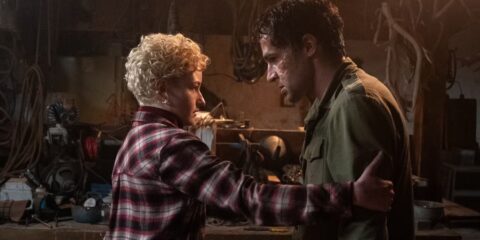If you took “and half at one another’s throats” from Philip Larkin’s iconic poem “This Be The Verse” (1971) — detailing generational trauma in savage, lyrical, concise detail — and made it into a feature-length film with some mild horror elements, you might come up with something like Wolf Man (Leigh Whannell, 2025). Using lycanthropy, i.e. turning into a fucked-up werewolf, as a metaphor for emasculation and being unable to deal with your own father’s trauma, this lazy, so-called “elevated” remake of the Universal Monsters classic The Wolf Man (George Waggner, 1941) removes all of the early film’s rich atmosphere and characterisation in favour of a flat body-horror that neither excites nor inspires.
Do you ever wonder why werewolves are almost exclusively men? It’s almost as if turning into a werewolf is a man’s way of returning to his most base self. His true self… In the original film, Lon Chaney Jr’s character, afraid to live up to his Welsh father’s legacy, lusts after a taken woman only to be infected by Bela Lugosi’s gypsy-wolf hybrid. His werewolf self thus becomes the unleashed sexual being who can then do whatever he wants, social norms be damned1I recently saw this sense of suppressed sexual (and/or creative) drive being unleashed to bizarre yet intermittently compelling effect in the Jack Nicholson-starring Wolf (Mike Nichols, 1994), enabling the already-old Nicholson to seduce Michelle Pfeiffer at the height of her beauty, even while competing with the equally handsome young James Spader..
Wannell’s version inverts Waggner’s creation. Instead of Claude Rain’s haughty father, pooh-poohing any mention of wolfmen or their variants, we have the strict Grady Lovell (Sam Jaeger), living remotely in a cabin in Oregon with his sensitive son Blake (Zac Chandler). After being pursued by a strange creature in the woods, Grady is now convinced that the local myth of the Face of the Wolf is real. But as Blake is constantly shouted at by his overly demanding, sensitive and protective father, you could say that the real monster in The Wolf Man is fatherhood itself. Man handing misery onto man. Etc, etc.
The film skips 30 years later, with Blake (now played by Christopher Abbott) finding himself yelling at his daughter for disobeying his orders. He wants to protect her, of course, but sometimes he occasionally acts like the very man he thought he wouldn’t be! In these early scenes, we see Abbott’s strong capacity for creating sensitive and nuanced male characters, treading the line between a modern, can-do-it-all man and traditional masculinity with genuine finesse.
Julia Garner, playing breadwinner journalist wife Charlotte (Julia Garner), is less impressive. While her passivity worked to her advantage in the Weinstein-era The Assistant (Kitty Green, 2019), her supposedly headstrong portrayal of a wife supposedly emasculating her husband lacks much presence whatsoever, developing into a fatal flaw when she needs to be the compelling final girl.
Together they are an unhappy couple, the stay-at-home Blake finding the perfect excuse to reinvigorate their marriage upon the official confirmation of his father’s death. His father’s body, of course, was never found, he merely went missing in the woods looking for the werewolf, but it provides them with the impetus to leave the city for a while and re-enact a third-tier Stephen King novel in the beautiful Oregon mountains. Soon they are chased by a metaphor, with Blake slowly but surely transforming into the eponymous name of this unengaging and inspiring film.
What makes Wolf Man so unsatisfying is not only does lycanthropy become a lazy metaphor about fatherhood, but that his transformation into a wolf does not stem naturally from his desire to be a real man, but is hastily thrust upon him by a shock development, hollowing out the central allegory entirely. The characters are severely underwritten, seen as shortcuts to cheap horror thrills as opposed to complex people in and of themselves. It also doesn’t help that the images look murky, most scenes are shot in the dark, and the final werewolf looks less like a man-wolf hybrid and more like a waxwork monkey. And while the grossout sequences — nails falling off, teeth going missing, the sucking of blood and the loss of hair — might draw some shocks across cinemas, they’re unlikely to genuinely thrill more discerning horror lovers.
This is the second Universal monster remake directed by Leigh Wannell2And the second Universal remake following The Wolfman (Joe Johnston, 2010), which was a box office and critical bomb yet did win an Academy Award for Best Makeup. following his well-received version of The Invisible Man (2020), which used the negative presence of the villain as a stylistic gambit to mount a series of satisfying filmmaking tricks upon. It also helped that it starred Elisabeth Moss, who is able to imbue even the most minor of characters with a great lived-in intensity.
Meanwhile, The Wolf Man feels like diminishing returns, showing that not every classic Universal Monsters movie needs a contemporary update. What next? Dracula with anxiety? Frankenstein with trauma? The Mummy… with mummy issues? Please. It’s worth pointing out that the original film was not based on any pre-existing property, but stewed in generalised legends around werewolves that had existed in the popular imagination for centuries. More of that original energy was needed here.

Redmond is the editor-in-chief of Journey Into Cinema.
